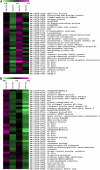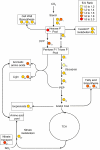The effects of elevated CO2 concentration on soybean gene expression. An analysis of growing and mature leaves
- PMID: 16877698
- PMCID: PMC1557602
- DOI: 10.1104/pp.106.086256
The effects of elevated CO2 concentration on soybean gene expression. An analysis of growing and mature leaves
Abstract
Improvements in carbon assimilation and water-use efficiency lead to increases in maximum leaf area index at elevated carbon dioxide concentration ([CO(2)]); however, the molecular drivers for this increase are unknown. We investigated the molecular basis for changes in leaf development at elevated [CO(2)] using soybeans (Glycine max) grown under fully open air conditions at the Soybean Free Air CO(2) Enrichment (SoyFACE) facility. The transcriptome responses of rapidly growing and fully expanded leaves to elevated [CO(2)] were investigated using cDNA microarrays. We identified 1,146 transcripts that showed a significant change in expression in growing versus fully expanded leaves. Transcripts for ribosomal proteins, cell cycle, and cell wall loosening, necessary for cytoplasmic growth and cell proliferation, were highly expressed in growing leaves. We further identified 139 transcripts with a significant [CO(2)] by development interaction. Clustering of these transcripts showed that transcripts involved in cell growth and cell proliferation were more highly expressed in growing leaves that developed at elevated [CO(2)] compared to growing leaves that developed at ambient [CO(2)]. The 327 [CO(2)]-responsive genes largely suggest that elevated [CO(2)] stimulates the respiratory breakdown of carbohydrates, which provides increased energy and biochemical precursors for leaf expansion and growth at elevated [CO(2)]. While increased photosynthesis and carbohydrate production at elevated [CO(2)] are well documented, this research demonstrates that at the transcript and metabolite level, respiratory breakdown of starch is also increased at elevated [CO(2)].
Figures







References
-
- Abe T, Thitamadee S, Hashimoto T (2004) Microtubule defects and cell morphogenesis in the lefty1lefty2 tubulin mutant of Arabidopsis thaliana. Plant Cell Physiol 45: 211–220 - PubMed
-
- Ainsworth EA, Davey PA, Bernacchi CJ, Dermody OC, Heaton EA, Moore DJ, Morgan PB, Naidu SL, Ra HSY, Zhu XG, et al (2002) A meta-analysis of elevated [CO2] effects on soybean (Glycine max) physiology, growth and yield. Glob Change Biol 8: 695–709
-
- Ainsworth EA, Walter A, Schurr U (2005) Glycine max leaflets lack a base-tip gradient in growth rate. J Plant Res 118: 343–346 - PubMed
-
- Avery GS (1933) Structure and development of the tobacco leaf. Am J Bot 20: 565–592
-
- Bernacchi CJ, Leakey ADB, Heady LE, Morgan PB, Rogers A, Long SP, Ort DR (2006) Hourly and seasonal variation in photosynthesis and stomatal conductance of soybean grown at future CO2 and ozone concentrations for three years under fully open air conditions. Plant Cell Environ doi/10.1111/j.1365-3040.2006.01581.x - PubMed
Publication types
MeSH terms
Substances
LinkOut - more resources
Full Text Sources
Molecular Biology Databases

